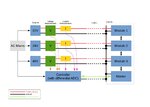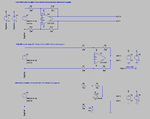dohzer
Member level 1
I've got a device I need to connect to multiple power supplies and a controller for testing. The device has several modules that all operate off different voltages (12V, 24V and 48V).
The device under test (DUT) has a housing that is used as a common ground point, with all the supplies and controllers connected to it in a star ground configuration via cables (red supply and black ground lines on the diagram).
External to the DUT I need to measure the supply voltages and currents (orange and pink lines on the diagram).
I don't want to create ground loops, so I'm thinking I will need to use differential measurements for each voltage/current signal.
The current measurements will be taken across a shunt resistor.
I have differential ADCs in the controller.
I'm a little overwhelmed with the number of different op-amps and configurations I could use.
What would be the best configuration for this setup?
General setup:

The device under test (DUT) has a housing that is used as a common ground point, with all the supplies and controllers connected to it in a star ground configuration via cables (red supply and black ground lines on the diagram).
External to the DUT I need to measure the supply voltages and currents (orange and pink lines on the diagram).
I don't want to create ground loops, so I'm thinking I will need to use differential measurements for each voltage/current signal.
The current measurements will be taken across a shunt resistor.
I have differential ADCs in the controller.
I'm a little overwhelmed with the number of different op-amps and configurations I could use.
General purpose op-amps setup differentially, fully differential op-amps, instrumentation amplifiers.
Single-ended measurement to differential ADC input.
Differential measurement to single ended ADC (negative ADC input grounded).
Differential measurement to differential ADC input?
Single-ended measurement to differential ADC input.
Differential measurement to single ended ADC (negative ADC input grounded).
Differential measurement to differential ADC input?
What would be the best configuration for this setup?
General setup:

